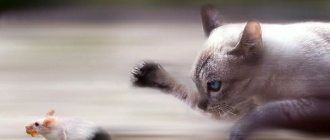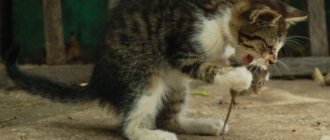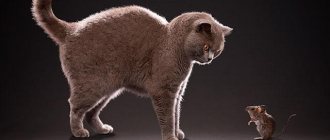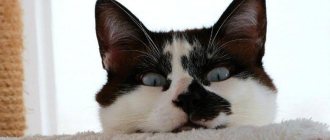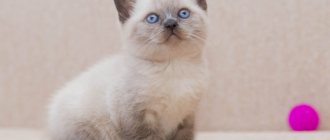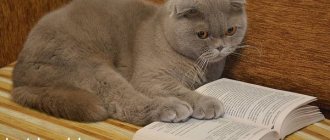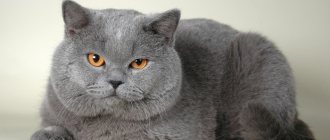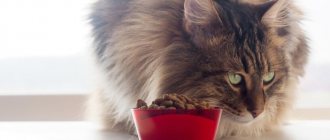Cats, both purebred and mongrel, are predators by nature. They have all the necessary “equipment” for hunting: sensitive hearing, instant reaction, sharp vision, as well as a unique, but no less formidable “weapon” - teeth and claws.
British cats are no exception. They have the instinct to hunt for everything that moves or simply moves: the owner’s leg (arm), a thrown candy wrapper, an accidentally flown fly and other relatively large insects.
Naturally, the nimble mouse, which the cat sees, also becomes prey.
In ancient castles in England, British cats have long served as a means of getting rid of overly impudent mice. For the same reason, the tradition arose of letting a cat into a new home first: it must clear the house of mice before people move in.
Quite often, British owners, taking their mustachioed pets to the countryside for the whole summer, then spend a long time telling friends and relatives about their hunting exploits. By the way, the British take great pleasure in hunting frogs, moles, lizards and small birds in addition to mice.
Not being hungry, they will definitely bring the prey home to “show off” and ask for the praise of their owners. Just one week is enough for the cat to completely rid the dacha of mice. Having finished with them, she begins to hunt May beetles, dragonflies, and butterflies.
It is a known fact that cats are much better hunters than cats. Hunting is also more successful for animals that are not overweight. In short, if your home has been “occupied” by mice, it is the British who will help you forget about them forever.
More in Poroda
All about the British cat breed
The British are perhaps the most popular breed among cat lovers. It attracts with its appearance, character, and ease of care and maintenance. “The British” attract and how...Read more →
Lilac British cat
British Lilac cats are considered the most beautiful cats. It is precisely them that will be discussed in this article. It’s very difficult not to love cats of this breed, because...Read more →
Types of British cats
British Shorthair cat, British General information about the breed and character, Types, standards and varieties, Choosing a British kitten, Features of keeping, feeding, caring for a British cat, Phenological nurseries...Read more →
Find out - do British cats catch mice?
Cats, both purebred and mongrel, are predators by nature. They have all the necessary “equipment” for hunting: sensitive hearing, instant reaction, sharp vision, as well as a unique, but no less formidable “weapon” - teeth and claws.
British cats are no exception. They have the instinct to hunt for everything that moves or simply moves: the owner’s leg (arm), a thrown candy wrapper, an accidentally flown fly and other relatively large insects.
In ancient castles in England, British cats have long served as a means of getting rid of overly impudent mice. For the same reason, the tradition arose of letting a cat into a new home first: it must clear the house of mice before people move in.
Quite often, British owners, taking their mustachioed pets to the countryside for the whole summer, then spend a long time telling friends and relatives about their hunting exploits. By the way, the British take great pleasure in hunting frogs, moles, lizards and small birds in addition to mice.
Not being hungry, they will definitely bring the prey home to “show off” and ask for the praise of their owners. Just one week is enough for the cat to completely rid the dacha of mice. Having finished with them, she begins to hunt May beetles, dragonflies, and butterflies.
It is a known fact that cats are much better hunters than cats. Hunting is also more successful for animals that are not overweight. In short, if your home has been “occupied” by mice, it is the British who will help you forget about them forever.
The British are considered noble purebred cats. And the black Briton simply captivates with its magical beauty, mystery and uniqueness. The British fur coat is saturated with black color from the very roots. It is uniform throughout… Read more &
Source
Do Scottish cats catch mice?
Scottish Fold. Myths and reality of cats with flattened ears
Scottish Fold is one of the most discussed breeds, causing many conflicting opinions and heated debates. There are breeders who successfully work with it and do not know any problems, and there are felinologists who consider this breed almost genetic garbage and write about endless diseases to which, in their opinion, folds are susceptible. Some felinological systems accept the “Scots” with open arms, while others are categorically against folds and at each General Assembly they postpone the decision on their registration indefinitely.
Some, based on Scottish Folds, create such outlandish breeds as the Ukrainian Levkoy, while others, to put it mildly, do not like Folds for their success and are afraid that the demand for kittens of similar straight-eared breeds may soon fall due to fold-eared competitors. The Scottish breed literally drowned in disputes and disagreements. It is already difficult to distinguish myths from truth. Therefore, I want to figure out who the Scottish really are and do they have dark secrets?
Scottish Folds are a breed based on a natural genetic mutation. An ordinary domestic cat living on a farm in Scotland gave birth to kittens in 1961, one of which had its ears folded and pressed against its head. The owners named the baby Susie and did not pay much attention to her unusual appearance. Susie walked around the farmland, was excellent at catching mice and did not think about the fact that she would soon become the founder of a unique breed - the Scottish Fold. A turn in her fate occurred in the same year, when British cat breeders William and Mary Ross saw Susie while walking and were amazed by her small ears folded in half. The breeders immediately asked the owners to give them a kitten from Susie if he inherited
Source
Scottish lop-eared
Some people mistakenly call this breed the British Fold, but this is incorrect. The Scottish Fold cat is only distantly related to the British Fold. This name comes from the time when fold-eared cats bred with the British, then the part of the litter that was produced with folded ears was called by amateurs - British Fold.
Breeding Scottish Fold cats is difficult because a cat can have a Scottish Fold dad or mom, but only one of the parents. When the fluffy lumps appear, whether the kittens are fold-eared or not, it becomes clear not immediately, but after about three weeks, when part of the litter leaves the ears at the top, and some become real fold-eared cats and cats.
Scottish kittens, fold-eared or not, are surrounded by various myths regarding care and education. For example, it is often claimed that Scottish Fold kittens should not eat calcium, but this is not true. Whether a Scottish fold cat or an ordinary cat, everyone needs calcium, as well as good nutrition, care and affection from a loving owner.
It is also believed that kittens, if they are lop-eared, have difficulty hearing. But this myth can be easily dispelled by simply rustling the candy wrapper a little, and the baby will immediately show that, despite his folded small ears, he hears wonderfully.
At any age, the Scottish Fold cat remains affectionate and playful. Whether you are going with him to an exhibition or showing him off to surprised guests, the Scottish Fold cat will invariably make an impression, and especially people unfamiliar with the Scottish Fold cat breed are touched by kittens that are fold-eared and so funny.
1. Dry food is always freely available + the availability of fresh water is always important. Dry food contains the ENTIRE range of essential vitamins and minerals.
3. Beef and veal, raw, scalded and boiled (mainly
Source
Special habits of the Scots
Scottish Fold Description of the character of the Scottish Fold cat can be described by their characteristic habits:
- Interesting and even funny leisure habits. They sleep on their backs, which is not typical for cats in principle. This sleeping position is not observed in any other breed of cat.
- Observing something while standing on its hind legs if the object is high.
- To attract attention and receive its share of affection, it can purr and rub its muzzle against a person.
- Can't stand being held or being squeezed. The cat may show its displeasure.
- In pursuit of an object of interest to them, for example, when playing with a person, they run very fast and can climb onto a hill. They jump well, run and have well-developed muscles.
- Scottish cats are usually silent. They voice only in important situations, in their own opinion. If you come across a sociable individual, you need to understand that he will become too sociable. He will accompany with his comments every step of the owner and his own. Many people don't like this behavior. Therefore, it is worth taking a closer look at the animal’s character while still in the nursery.
fold cat catches mice
Why does a cat catch a mouse?
Hello, friends. Today I would like to discuss one interesting topic with you. We all know that cats love to hunt mice. But why does our cat catch the mouse? After all, it seems like a simple question, but it’s not easy to answer. After all, no one seems to have thought about why cats catch mice so passionately. Why not insects or lizards, but mice with such passion?
I all thought I saw a cat going out of the house into the street. She immediately begins to listen and sniff everything and thereby receive the information she needs. And then she discovers traces or the smell of mice, near some kind of mink. So what happens next? Right. She takes a comfortable position and begins to wait. This wait may take several hours. Yes, we should envy such patience.
And so the cat catches the mouse. Bam, one moment and the hunt was a success. And our winner does not immediately eat it. The cat takes it away from the hole and begins to play with it until the mouse no longer shows signs of life. And then you think he’ll eat it? Not always. Some cats bring their prey into the house and place it in front of the owner. You just have to guess why. Maybe out of a feeling of gratitude, as if saying “look what a delicacy I brought you” or to show your importance.
I would also like to say about the cat’s other hobbies. This includes bird hunting and fishing. In the first case, hunting takes place on the ground, when any unwary bird will not notice the danger. In this case, she should only count on the cat's .
But when it comes to fishing, it’s amazing. As we know, cats dislike water, but despite everything, they have a desire to sit on the shore of a pond and wait for their prey. After all, the reward will be fresh fish, from which they
Source
Which cats are better at catching rats and mice?
Despite innovations, the most effective rodent exterminator remains the common cat. Initially, thanks to this quality, cats were able to win the love of humanity. Today, a cat is a friend and family member. However, the skills of a hunter and a ruthless exterminator of rodents are in demand to this day. Which cats catch rats masterfully, leaving no chance for the pests?
Yard VS Thoroughbred
The hunting instinct is alive in every cat, regardless of the presence or absence of breed. But in order to have the honor of being called the best hunter, the degree of expression of this instinct is important. In most cases, a purebred cat catches a mouse simply out of curiosity. She doesn’t try to eat her and doesn’t even always kill her: over the years of selection, breeders have managed to euthanize the cats’ natural inclinations, making these animals more suitable for life in a city apartment.
So which cats are better at catching mice? It turns out that they are outbred? However, this is not always the case. Many owners deliberately breed completely domestic mongrel cats, but these cats also live in urban conditions, in apartments, and they see mice no more often than their blue-blooded brothers. If suddenly such a cat catches a rat, it plays with it for a long time, drags it back and forth, without trying to kill it with a precise bite to the back of the head, as real hunters do. And all because, in addition to a pronounced instinct, a cat requires skill. But how to teach a cat to catch mice?
This experiment was carried out back in the 1960s. Four cats and their offspring took part in it. The two cats were pedigree, and the cats for mating were selected accordingly. The other two are skilled hunters living on farms, mated with the same cats. Scientists made a substitution: outbred kittens were placed in purebred cats, and purebred babies were placed in farm cats. When the litters weren't even three
Source
Cat breeds - Scottish Straight. Scottish Straight, Scottish Straight Cat
- Able to hear absolutely straight, sideways and up)). Richard the Lionheart, whiskey, hills, kilts and fogs... Yes, straight-eared Scots honor the traditions of their homeland. Join Scotland - buy Scottish Straight!
Photos of the Scottish Straight (Scottish Straight)
Video of the Scottish Straight breed
Description of the breed, breed standards Scottish Straight (Scottish Straight)
The body of the Scottish Straight: is of medium size, round in shape and smooth, massive and muscular from the shoulders to the pelvis, the chest and shoulders are well developed.
Scottish Straight Tail: May be of medium length or long, proportional to the body, flexible, tapering to a tip that is rounded.
The head of the Scottish Straight: It has a rounded shape, smoothly turning into a short neck, with a strong chin and strong jaws, the rounded whisker pads (whiskers) are noticeably pronounced.
Scottish Straight eyes : Large, round, wide open, separated by a wide bridge of the nose. The color of the eyes should match the color.
Scottish Fold body: medium size, round in shape; from the shoulders to the pelvic area it is smooth, massive and muscular, the chest and shoulders are at a fairly developed level.
Types of colors of the Scottish Straight (Scottish Straight)
Parameters, size, weight of the Scottish Straight (Scottish Straight)
Character of the Scottish Straight (Scottish Straight)
The Scottish Straight cat has a peaceful character. Scottish Straights often have a pet from among their owners, with whom they try to spend more time. Like all cats, Scottish Straights enjoy the affection and attention of their owners.
It cannot be said that Scottish straight-eared cats will persistently demand their owner’s attention,
Source
Appearance of the ratcatcher cat
It is believed that a mousecatcher cat must have a special appearance. Which pet rat catchers catch mice better than others can be determined by their appearance.
Such pets should have long whiskers. The best hunters have a special camouflage color - black, gray, red, with faint stripes or spots. White animals will be more noticeable, which means their camouflage may fail them at the most crucial moment. It has long been believed that the tricolored female is the ideal rat catcher. Cats with this color simply do not exist.
The coat should be short. It is believed that short-haired animals are the best rat catchers. Of the long-haired breeds, only a few breeds are distinguished, for example, the Turkish Angora or the Norwegian Forest breed. Long hair interferes with successful hunting. However, you can find an excellent rat catcher among long-haired purebred animals.
The rat catcher has a triangular shaped head. You can tell that a cat is a rat catcher by pressing its ears to the base of its skull. It is also noted that the presence of large ears, especially with tassels, is an important sign of a rat catcher.
There are no perfect rodent hunters, just as there are no cats that do not hunt at all. All cats are rat catchers and catch rodents. It is worth noting that some representatives of the breed can exterminate mice better than others.
The most popular cat breeds: Scottish Fold (PHOTO), care, character
These creatures look attentively and in amazement at the world with huge round eyes of amber, gray, green, orange, and when they turn to you with a proud profile, you can see a small humped nose and a sloping forehead with powerful brow ridges. And immediately a powerful rumbling is heard - simply because they are happy to see you.
People love cats, that's an undeniable fact. Moreover, people love all kinds of cats: huge Maine Coons with charming tufts on their ears, funny short-legged and long munchkins, tailless brave bobtails, curly rexes, hairless sphinxes, which don’t even look much like cats, vindictive Siamese, ordinary gray and spotted “ Murok" - there is no need to list all the breeds, of which there are only 70 officially, and unofficially more than 100. People just love cats.
Have you ever seen wonderful creatures that look like they have an invisible bandana tied around their head, pressing their ears tightly and bending them forward? These creatures look attentively and in amazement at the world with huge round eyes of amber, gray, green, orange, and when they turn to you with a proud profile, you can see a small humped nose and a sloping forehead with powerful brow ridges. And immediately a powerful rumbling is heard - simply because they are happy to see you. Here are Scottish Fold cats - Scottish Fold.
Scottish fold cats
Scottish is a very young breed, the first representative of which, a funny white cat with funny, forward-curved ears, was seen by a certain William Ross on an unknown farm in the north-west of Scotland exactly 50 years ago. I saw it and bought it, being moved by the appearance of the animal, which resembled an owlet and a bear cub at the same time. The kitten grew into a luxurious beast, which became the ancestor of unusual cats, and in 1978
Do Scottish cats catch mice?
Scottish Fold. Myths and reality of cats with flattened ears
Scottish Fold is one of the most discussed breeds, causing many conflicting opinions and heated debates. There are breeders who successfully work with it and do not know any problems, and there are felinologists who consider this breed almost genetic garbage and write about endless diseases to which, in their opinion, folds are susceptible. Some felinological systems accept the “Scots” with open arms, while others are categorically against folds and at each General Assembly they postpone the decision on their registration indefinitely.
Some, based on Scottish Folds, create such outlandish breeds as the Ukrainian Levkoy, while others, to put it mildly, do not like Folds for their success and are afraid that the demand for kittens of similar straight-eared breeds may soon fall due to fold-eared competitors. The Scottish breed literally drowned in disputes and disagreements. It is already difficult to distinguish myths from truth. Therefore, I want to figure out who the Scottish really are and do they have dark secrets?
Scottish Folds are a breed based on a natural genetic mutation. An ordinary domestic cat living on a farm in Scotland gave birth to kittens in 1961, one of which had its ears folded and pressed against its head. The owners named the baby Susie and did not pay much attention to her unusual appearance. Susie walked around the farmland, was excellent at catching mice and did not think about the fact that she would soon become the founder of a unique breed - the Scottish Fold. A turn in her fate occurred in the same year, when British cat breeders William and Mary Ross saw Susie while walking and were amazed by her small ears folded in half. The breeders immediately asked the owners to give them a kitten from Susie if he inherited
Source
Does the Scottish Fold cat catch mice?
Maine Coon: Questions and Answers
Unicum Cattery is pleased to offer connoisseurs of real Maine Coons magnificent kittens of the most famous bloodlines,
combining rare patterns (including ticked in various colors), amazingly stable breed type and an indescribable temperament that has become. In recent years, there has not been an exhibition from which our pets did not return with victories, and four stud cats entered the prestigious list of the best animals in the country according to the FIFe system, topping it in the overall standings.
Sharm World Kennel offers the best Maine Coons of the modern extreme type.
Our professional knowledge and more than 20 years of experience in breeding work have allowed us to unite in the nursery exclusive producers of the rarest lines, which have no analogues either in Russia or in Europe. Thanks to the highest quality breed characteristics, our kittens combine not only stunning show type, but also impressive size. The brand of the Sharm World kennel is the unique style of its Maine Coons, which cannot be repeated or faked. Information about kittens on the website https://sharm-world.ru
BekkerCoon Cattery breeds the largest domestic cats - the traditional Maine Coon and the polydactyl ancient Maine Coons with extra toes.
Our producers came to us from famous nurseries in America and Germany.
From time immemorial, the image of a cat accompanies humans. The Egyptians saw the cat as the embodiment of the goddess Bastet, who was depicted as a woman with the head of a cat, surrounded by playing kittens. This goddess was considered a protector
hearth and patroness of love and women. Cats were held in high esteem as companions of the goddess who conveyed people's requests to her. They were honored even after death
Source
Which cats are better at catching mice?
How many people - so many opinions. You are once again convinced of the correctness of this expression when faced with the question of which breed of cat is the best at catching mice. Every self-respecting owner, of course, claims that the best breed of cat for catching mice is the one to which his pet belongs. If the pet is outbred, then these tailed children of the street are declared unsurpassed hunters.
Some claim that the ideal rat-mouse catcher is a long-nosed red cat, others that it is exclusively a tricolor cat, and still others give the palm to striped, big-eared animals.
Previously, when no one even knew about the existence of cat breeds, and they also did not attach importance to external data, which cats caught mice and rats better than others were determined by the cat’s “registration”. Thus, Catherine II “ordered” the mustachioed guards of the Winter Palace from Kazan and Tsarevokokshaisk (now Yoshkar-Ola).
After the siege of Leningrad, when there were no cats left in the city, but there were hordes of rats, tailed ones were imported from Yaroslavl and Siberia - then the cats there were considered the fastest and most dexterous.
Which cats catch mice and rats: heredity and upbringing
Half a century ago, an experiment took place in which cats and kittens were involved. Two “families” were purebred, and two were “noble families” living in rural conditions. The cats were replaced with babies, giving them to simple purebred cats and vice versa. When the kittens were about three weeks old, the village cats began teaching the children how to hunt in practice by bringing them mice they had caught.
The little “nobles”, under the leadership of high-born “mothers” at that time, were simply playing at hunting; they did not have the need, and indeed the opportunity, to kill the victim. As a result, it turned out that which cats catch mice and rats is influenced not only by heredity, but also by upbringing. A living example of a hunter cat, free access to additional
Source
Which cats catch mice and rats, heredity and upbringing
Let's look at which cats are better at catching mice. First of all, the success of the hunt depends on the color of the pet. If the color of the animal is black, gray, red, there are dim spots or stripes, then it will be much more convenient for him to hunt, it will be easier for him to merge with nature.
Domestic rat-catching cats catch mice because of the hunter's instinct, developed in them since childhood. All harmless games with a pet using “teasing” are actually preparing the pet to pursue and prey on its prey.
Homeless yard animals, just like domestic animals, follow their instincts. For them, hunting serves as a direct source of food and a way to survive.
There is an opinion that castrated cats are worse at catching mice and rats. Your pet's behavior can change greatly after sterilization. Because of this, many rural residents wonder whether a neutered cat will also deftly exterminate rodents or will it lazily sleep all day long.
Hypothetically, the hunting instinct should not be lost in the pets of rat catchers. However, in reality everything happens differently. If the rat catcher cat does not eat properly, it quickly gains weight, which causes laziness, apathy and leads to a slowdown in metabolism. It will be very difficult for the pet to hunt, so it may stop exterminating rodents. The rat catcher needs to be fed correctly after sterilization.
It is believed that the difference between outbred and purebred animals lies not only in appearance, but also in the complete absence of hunting instincts in the latter.
Owners of domestic cats believe that only domestic animals, which have been trained from childhood by their mother mousetrap to obtain food, can be rat catchers. However, this is not quite true. There are many purebred pet rat catchers who catch mice no worse than domestic ones.
Character of British cats
These pets have been attracting a lot of attention since time immemorial. In the article we will take a closer look at the character and behavior of British cats, and also find out how they get along with children and whether they catch mice in the house. The owners of these plush pets are always surrounded by love and affection.
Character of British cats
Like any breed of cat, the British are characterized by certain traits in character and behavior. The name of the British Shorthair breed speaks of aristocracy, endurance and endurance, which are inherent in a real Englishman.
Aristocratism is also evident in the British Longhairs. From an early age, they are particularly clean - they take care of their fur and do not allow themselves to create a mess in the house. For the first 2-4 months of life, kittens like to play and frolic, but in adolescence, the British become more sedate.
British cats can be safely called calm and friendly animals. Thanks to their inexhaustible patience, they get along well with all family members and other animals.
Despite the fact that British cats are affectionate and gentle creatures, they still cannot tolerate excessive familiarity. Pet owners note that straight-eared Britons do not like to sit on their hands for a long time and allow themselves to be petted only with their permission.
They are not at all offended by the long absence of their owner, and faithfully wait for him all day long. However, it is not recommended to limit your pet’s freedom in the house - be sure to leave the interior doors open before leaving. Otherwise, upon your return, you will notice your pet’s offended look and doors damaged by claws.
A feature of the breed is independence. Britons are ideal animals for people who work for a long time.
This breed of cat does not like to be angry or shouted at. However, m
Source
Search form
Main menu
British behavior
A British breed cat does not like loud noises, and therefore tries to talk quietly and purr only when absolutely necessary. The British value their relaxation and privacy very much. They can easily sleep up to 20 hours a day.
The British cat is the personification of calm and true comfort in the home.
It is very important for a cat of this breed to know that she is loved. Some Britons even become jealous of their owner if he devotes a large amount of time to someone else. But a “tame” British cat is a rarity. The animal sits in the arms of the owner for a maximum of 5 minutes a day, and then, pretending to be a deep favor.
British cat care and maintenance >>
At the same time, other family members can only dream of holding him. Pure-blooded Britons sometimes even attack and bite strangers. It is possible to change such habits of an animal only in childhood, constantly exposing it to new people. This way the British cat will know that there are different smells and hands.
A feature of the behavior of British cats is “licking” and washing themselves after any psychological stress, for example, a serious “conversation” with the owner, a trip to an exhibition or a visit to the veterinarian. But it's not just stress that causes cleanliness for the British. Thanks to their innate aristocracy, these animals never shit in the wrong place, provided that their tray is clean. Only during puberty, like any member of the cat family, can Britons begin to mark their territory. Therefore, if you are not going to continue the offspring of your pet, it is better to castrate a British cat at the age of 8-10 months, and sterilize a cat.
Do Scottish cats catch mice?
For many people who have mice in the house, it would be important to get a cat that will help cope with this problem. But sometimes you want to combine business with pleasure, so that the cat not only catches rodents, but also is beautiful and kind. Let's see if this can be combined in the Scottish breed?
According to numerous testimonies from owners, the Scottish cat catches mice, but she does it much less skillfully than the rat catcher. Plus, for her it’s just entertainment: today I want to catch it, I catch it, tomorrow I don’t want to, I don’t catch it. Although purely physically there is such a possibility.
In general, Scottish cats are quite agile, so animals do not escape from them very often. But they lack aggression and can give up before an opponent’s aggression, so it’s not worth sending them to attack rats.
And yet, whether the Scottish cat will catch even small mice is a rather controversial question. Here everything still depends on the individual character of the pet: there are Scottish cats that are just louts, and there are aggressive torpedoes (although this is very rare, rather like an anomaly).
From all of the above, I would like to conclude: to catch mice, it is better to take another breed, and the ideal option is an outbred kitten from a mousetrap mother. Outbred cats are more likely to engage in this activity than purebred cats. In addition, a thoroughbred is more likely to be poisoned by a mouse if something is wrong with it. It’s a pity to force an expensive cat to catch mice, which should be a decoration of the house, and not a workhorse.
2 min — Uploaded by TVSmecta Pharmacy, instructions for use. Manufacturer: Ipsen Pharma
But at the same time, you need to take home not a mongrel cat raised in the house, but a cat from the street, raised by a mother who caught mice and passed on this experience to her children. An experiment was conducted in which scientists swapped kittens from purebred and outbred cats: in re
Source
Pied Piper Cat Breeds
If we talk about purebred animals intended for hunting, we should pay attention to indigenous breeds (bred not by breeders, but by nature itself). They are capable of great speed, but they cannot run at such speeds for more than 1 minute
A ratcatcher cat can cost a lot of money.
Foreign mousecatcher cats:
- Abyssinian. Good for catching mice. Has big ears.
- Turkish Angora. It differs from the others in its beautiful appearance. Has a wonderful character. Gracefully and skillfully catches mice.
- Bengalis. Very fast animals.
- European Shorthair.
- Siamese cat.
- Norwegian forest species. Excellent at catching large rodents.
Which purebred cat is the best at catching rodents among foreign native breeds - there is no definite answer to this question. Every owner of a purebred cat claims that his pet copes with the extermination of rodents in the best way.
Rodents among the cat breeds of aboriginal cats raised on the territory of Russia are best caught by several species. Cat breeds that are better at catching mice and rats:
- Cats of the Siberian breed. They have an obstinate character. Rodents cannot resist tenacious and powerful paws.
- Russian blue. An elegant, beautiful breed of cat, whose representatives are excellent hunters.
- Kurilian Bobtail. A real hunter. Not afraid to attack even dogs.
Of particular note is the foreign breed, which was originally created for catching rats and mice. This is the king of cats - Maine Coon. It has a large body size, erect, large ears with tassels. The fight against rodents is easy and relaxed. Representatives of this breed are considered good rat catchers.
Find out - do British cats catch mice?
Cats, both purebred and mongrel, are predators by nature. They have all the necessary “equipment” for hunting: sensitive hearing, instant reaction, sharp vision, as well as a unique, but no less formidable “weapon” - teeth and claws.
British cats are no exception. They have the instinct to hunt for everything that moves or simply moves: the owner’s leg (arm), a thrown candy wrapper, an accidentally flown fly and other relatively large insects.
In ancient castles in England, British cats have long served as a means of getting rid of overly impudent mice. For the same reason, the tradition arose of letting a cat into a new home first: it must clear the house of mice before people move in.
Quite often, British owners, taking their mustachioed pets to the countryside for the whole summer, then spend a long time telling friends and relatives about their hunting exploits. By the way, the British take great pleasure in hunting frogs, moles, lizards and small birds in addition to mice.
Not being hungry, they will definitely bring the prey home to “show off” and ask for the praise of their owners. Just one week is enough for the cat to completely rid the dacha of mice. Having finished with them, she begins to hunt May beetles, dragonflies, and butterflies.
It is a known fact that cats are much better hunters than cats. Hunting is also more successful for animals that are not overweight. In short, if your home has been “occupied” by mice, it is the British who will help you forget about them forever.
Contents 1. Groups of colors of the British Longhair cat 2. Colors of the British Longhair cat 3. Character of the British Longhair cat 4. Features of caring for the British Longhair cat 5. Health… Read more →
Source
British cat and children
British Shorthair cats easily get along in families with small children. In addition, the child will be able to easily involve the British in some kind game. The animal doesn’t mind chasing a ball, a car or a wind-up mouse together.
A kitten's favorite pastime can be a candy wrapper tied to a rope or even a simple piece of fabric, with which the pet can deftly run around the house. By the way, active rest is very beneficial for the health of British cats, since they are prone to obesity. However, children should not take advantage of the patient nature of the British. If you hold them by force or cause pain, the cat may release its claws, protecting its dignity.
How to name a British kitten >> How to name a kitten by the length of its fur >>
Most often, positive reviews about the relationship between British cats and children are left by owners of British longhairs and chinchillas. And it is not surprising, because these cats are distinguished by a more flexible character and intelligence. In addition, families with children are often recommended to adopt a Scottish fold cat, which always finds an approach to all residents of the house. How do the British differ from the Scots >>
